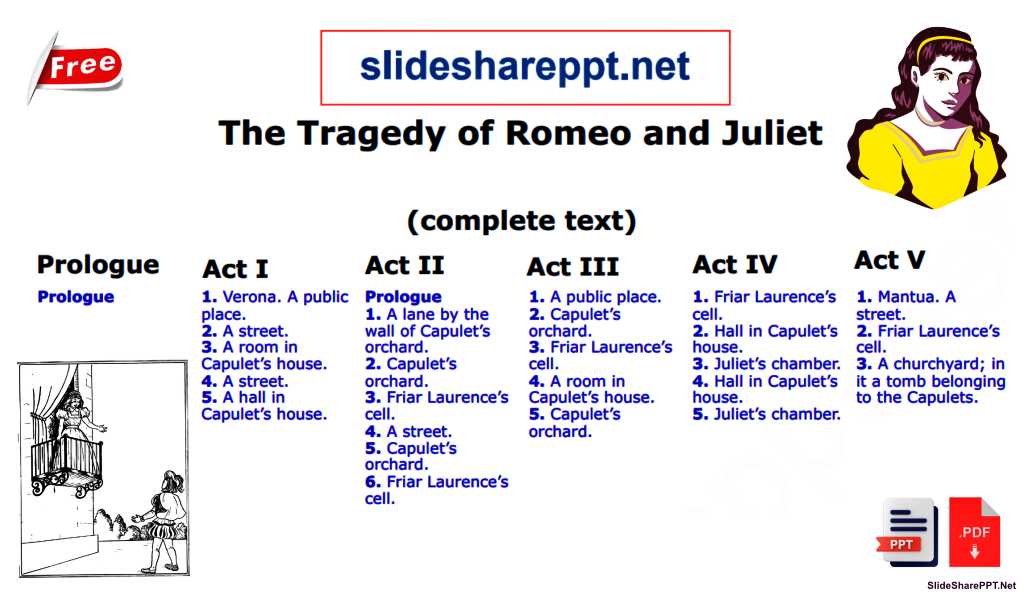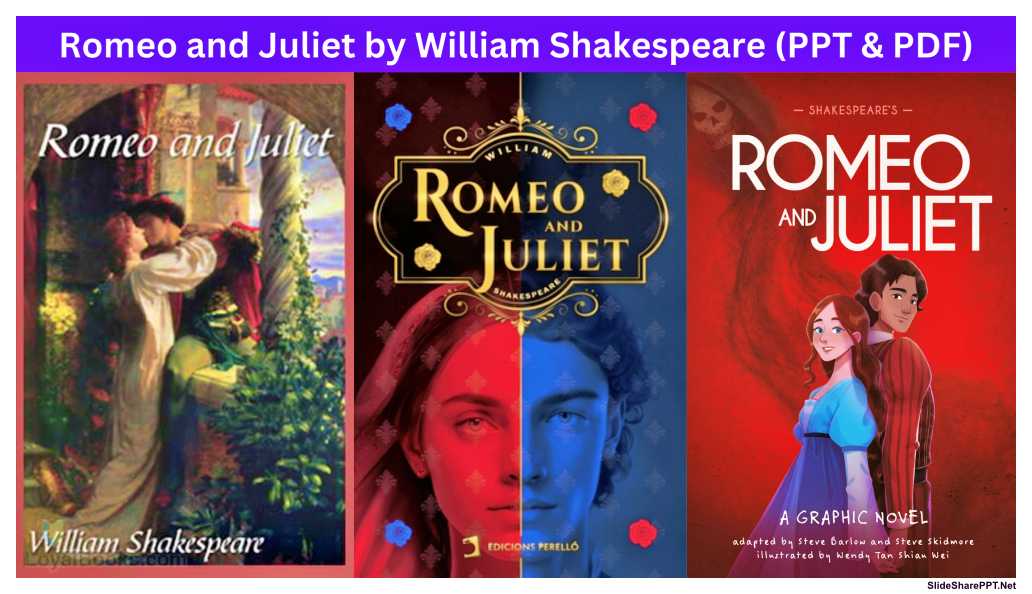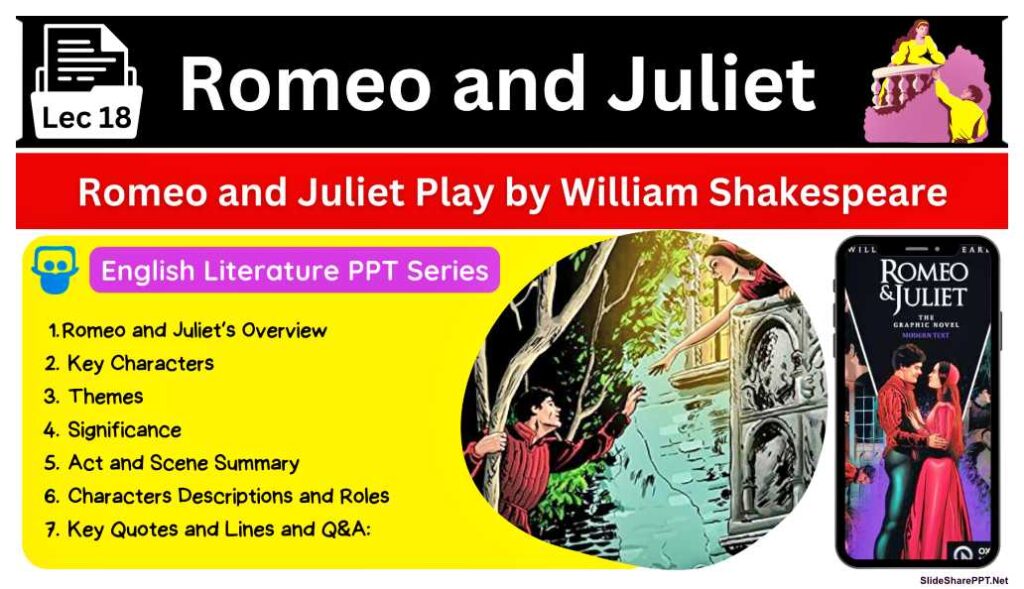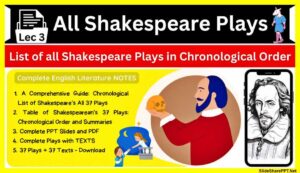Romeo and Juliet PPT Slides & PDF Download
Contents
Today we have shared the Notes of William Shakespeare’s Famous Play Romeo and Juliet PPT Slides & PDF Download, So as we know William Shakespeare’s timeless tragedy “Romeo and Juliet” stands as a testament to the enduring power of love amidst adversity. Set in the bustling city of Verona, this iconic play unfolds against the backdrop of a bitter feud between two noble families, the Montagues and the Capulets. Amidst the strife and discord, the fateful meeting of two young lovers, Romeo and Juliet, sparks a tale of passion, devotion, and tragedy that has captivated audiences for centuries. Shakespeare’s exploration of themes such as love, fate, and societal expectations resonates with audiences across cultures and generations, making “Romeo and Juliet” an enduring masterpiece of literature and drama.
Romeo and Juliet
Here’s a complete table for “Romeo and Juliet”:
| Aspect | Description |
|---|---|
| Title | Romeo and Juliet |
| Playwright | William Shakespeare |
| Genre | Tragedy |
| Date of Composition | Estimated to be between 1594 and 1595 |
| Setting | Verona, Italy |
| Main Characters | Romeo Montague, Juliet Capulet, Mercutio, Tybalt, Friar Laurence, Nurse, Lord Capulet, Lady Capulet, Lord Montague, Lady Montague |
| Plot Overview | The play tells the story of two young lovers, Romeo and Juliet, whose families are embroiled in a bitter feud. Despite the enmity between their families, Romeo and Juliet fall passionately in love and marry in secret. However, their love story ends in tragedy as misunderstandings and miscommunication lead to a series of fatal consequences. |
| Key Themes | Love, fate, the conflict between individual desire and social expectations, the consequences of impulsiveness and rash decisions |
| Significance | “Romeo and Juliet” is one of Shakespeare’s most famous and enduring works, celebrated for its lyrical language, vivid characters, and exploration of the intensity of youthful love. It has inspired countless adaptations, reimaginings, and interpretations across various media. |
| Notable Lines | – “What’s in a name? That which we call a rose / By any other name would smell as sweet.” (Act 2, Scene 2) – “Good night, good night! Parting is such sweet sorrow, / That I shall say good night till it be morrow.” (Act 2, Scene 2) – “For never was a story of more woe / Than this of Juliet and her Romeo.” (Act 5, Scene 3) |
| Adaptations | “Romeo and Juliet” has been adapted into numerous films, stage productions, ballets, operas, and other works of art. Notable adaptations include Franco Zeffirelli’s film (1968), Baz Luhrmann’s film (1996), and various stage productions by renowned theater companies. |
This table provides a comprehensive overview of various aspects of “Romeo and Juliet,” including its background, plot, characters, themes, significance, notable lines, and adaptations.
Romeo and Juliet PPT Slides
(Lecture 18)
Important:-
- If you are viewing this PPT on your phone, please make it full screen and then view it. (Press: 3 dots in PPT, then Full Screen)
- If you have a problem while clicking on next, (Just tap) on the slide instead of clicking Next Botton.
- FOR A BETTER VIEW PRESS Ctrl + Shift + F ON A PC OR LAPTOP.
- Whatever is written in the PPT is different and whatever is written below is different.

Note: The complete Text PDF Link is at the end of the PowerPoint slides (go to the last PPT Slide)
ROMEO AND JULIET by William Shakespeare
William Shakespeare’s “Romeo and Juliet” is a timeless tale of love, tragedy, and the complexities of human relationships. Written in the late 16th century, the play continues to captivate audiences worldwide with its poignant depiction of young love thwarted by familial discord and societal expectations. Let’s delve into the themes, characters, and enduring relevance of this iconic work.
The Tragic Love Story
- At its core, “Romeo and Juliet” is a tragic love story between two young individuals from feuding families, the Montagues and Capulets, in the city of Verona. Romeo Montague and Juliet Capulet meet and fall deeply in love at a masquerade ball, unaware of each other’s identities. Their love defies the longstanding enmity between their families, leading to a series of events that culminate in their untimely deaths.
Themes of Love and Conflict
- Love, in its various forms, is a central theme in the play. Romeo and Juliet’s love is passionate and idealistic, transcending societal barriers. However, it is also impulsive, contributing to their tragic fate. The play also explores familial love, particularly through the strained relationships between parents and children. The feud between the Montagues and Capulets serves as a backdrop, highlighting the destructive nature of unchecked conflict and the human cost of longstanding grudges.
Character Analysis
- The characters in “Romeo and Juliet” are vividly drawn and emblematic of different aspects of human nature. Romeo is a romantic idealist, prone to rash decisions driven by his emotions. Juliet, while initially sheltered, displays remarkable courage and determination in pursuing her love for Romeo. The supporting cast, including Mercutio, Tybalt, Friar Laurence, and the Nurse, each contribute to the unfolding tragedy through their actions and motivations.
Relevance and Interpretations
- Despite being set in Renaissance-era Italy, “Romeo and Juliet” remains relevant due to its exploration of timeless themes. The play’s examination of youthful passion, societal expectations, and the consequences of unchecked conflict resonates with audiences across cultures and generations. Productions and adaptations continue to reinterpret the story, placing it in modern contexts while preserving its core emotional resonance.
Lessons Learned
- “Romeo and Juliet” offers several lessons about love, conflict resolution, and the impact of impulsive decisions. It reminds us of the need for communication, understanding, and empathy in relationships, be they romantic or familial. The tragic outcome also serves as a cautionary tale about the dangers of unchecked hatred and the high price of unresolved animosity.
Conclusion
- In conclusion, Shakespeare’s “Romeo and Juliet” endures as a masterpiece of literature and drama, captivating audiences with its timeless themes, memorable characters, and tragic narrative. Its exploration of love, conflict, and human nature continues to resonate centuries after its creation, cementing its status as one of the most iconic works in the English literary canon.
Summary and Act
Here’s a table summarizing each act of “Romeo and Juliet”:
| Act | Summary |
|---|---|
| 1 | The feud between the Montagues and Capulets erupts in street fighting. Romeo Montague attends a Capulet party in disguise and meets Juliet Capulet. |
| 2 | Romeo and Juliet profess their love for each other and decide to marry secretly. Friar Laurence agrees to marry them, hoping to reconcile their families. |
| 3 | Tybalt, Juliet’s cousin, challenges Romeo, leading to Mercutio’s death at Tybalt’s hands. Romeo avenges Mercutio and kills Tybalt, resulting in his banishment from Verona. |
| 4 | Juliet fakes her death with a potion given by Friar Laurence to avoid marrying Paris, whom her parents have arranged for her. Her family mourns her supposed death. |
| 5 | Romeo hears of Juliet’s death and returns to Verona to kill himself beside her. He consumes poison, and Juliet awakens to find him dead. She then stabs herself with Romeo’s dagger. |
These acts provide a structured overview of the play’s progression from the initial feud to the tragic deaths of the young lovers. Each act contributes to the development of characters, themes, and conflicts, culminating in the poignant conclusion of “Romeo and Juliet.”
Themes
Here’s a table summarizing some key themes in “Romeo and Juliet”:
| Theme | Description |
|---|---|
| Love vs. Hatred | The passionate love between Romeo and Juliet contrasts sharply with the deep-seated hatred between their families, the Montagues and Capulets. |
| Fate and Free Will | The characters’ actions are influenced by fate, as seen in the series of events leading to the tragic conclusion, yet they also exercise free will. |
| Youth and Impulsiveness | Romeo and Juliet’s youthful passion and impulsive decisions drive the plot, highlighting the intensity and naivety of young love. |
| Conflict and Violence | The feud between the Montagues and Capulets fuels the conflict and violence that ultimately leads to tragedy, showcasing the destructive nature of unchecked animosity. |
| Individual vs. Society | The lovers’ desire to be together clashes with societal expectations and family obligations, underscoring the tension between personal desires and societal norms. |
These themes weave through the narrative, adding depth and complexity to the characters’ motivations and interactions in Shakespeare’s timeless tragedy.
Characters
Here’s a table summarizing the main characters in “Romeo and Juliet”:
| Character | Description |
|---|---|
| Romeo Montague | A romantic young man from the Montague family who falls deeply in love with Juliet Capulet. His impulsive nature and passionate emotions drive many of the play’s events, leading to both joy and tragedy. |
| Juliet Capulet | A young, innocent member of the Capulet family who falls in love with Romeo. Juliet is intelligent, determined, and willing to defy her family for love. Her strength and love for Romeo drive her actions throughout the play. |
| Friar Laurence | A well-intentioned Franciscan friar who plays a crucial role in Romeo and Juliet’s story. He marries the young couple secretly, hoping to reconcile their families, but his plans ultimately lead to tragic consequences. |
| Mercutio | Romeo’s close friend is known for his wit, humor, and loyalty. Mercutio’s death at the hands of Tybalt serves as a turning point in the play, escalating the conflict and leading to tragic consequences for Romeo and Juliet. |
| Tybalt Capulet | Juliet’s hot-tempered cousin and a skilled duelist. Tybalt’s aggressive nature fuels the feud between the Montagues and Capulets, leading to confrontations that contribute to the play’s tragic events. |
| Nurse | Juliet’s faithful and comedic nurse who has cared for her since childhood. Despite her bawdy humor, the Nurse provides emotional support and guidance to Juliet, playing a significant role in the lovers’ secret relationship. |
| Lord and Lady Capulet | Juliet’s parents who are embroiled in the feud with the Montagues. They play a central role in arranging Juliet’s marriage to Paris, unwittingly contributing to the tragic events that unfold. |
| Lord and Lady Montague | Romeo’s parents who are also part of the longstanding feud. Their concern for Romeo’s well-being is evident throughout the play, especially after Romeo’s banishment. |
| Paris | A nobleman and relative of the Prince who seeks Juliet’s hand in marriage. His betrothal to Juliet is part of the intricate web of events leading to tragedy. |
| Prince Escalus | The ruler of Verona who tries to maintain peace between the feuding families. His interventions and decrees reflect the escalating tensions and tragic consequences of the feud. |
| Benvolio Montague | Romeo’s cousin and trusted friend is known for his peaceful nature. Benvolio often tries to defuse conflicts between the Montagues and the Capulets. |
| Friar John | Another Franciscan friar who fails to deliver an important letter from Friar Laurence to Romeo, contributing to the tragic misunderstandings near the play’s end. |
These characters, with their varied personalities and motivations, interact to create the complex tapestry of “Romeo and Juliet,” showcasing love, conflict, loyalty, and tragedy in equal measure.
Significance and Legacy
Here’s a table summarizing the significance and legacy of “Romeo and Juliet”:
| Aspect | Description |
|---|---|
| Literary Masterpiece | “Romeo and Juliet” is regarded as one of Shakespeare’s greatest works, showcasing his mastery of language, characterization, and dramatic storytelling. |
| Iconic Love Story | The play’s depiction of passionate, youthful love has made it a timeless tale that continues to resonate with audiences across cultures and generations. |
| Exploration of Themes | It explores timeless themes such as love, conflict, fate, and societal expectations, providing rich material for interpretation and analysis. |
| Influence on Culture | The play has inspired countless adaptations, including films, ballets, operas, and novels, cementing its place in global cultural consciousness. |
| Popular Quotations | Famous lines such as “What’s in a name? That which we call a rose by any other name would smell as sweet” have become part of everyday language and literary lexicon. |
| Impact on Drama | “Romeo and Juliet” pioneered the tragic romance genre in drama, influencing subsequent playwrights and storytellers for centuries. |
These aspects highlight the enduring significance and profound legacy of “Romeo and Juliet” in the realms of literature, culture, and dramatic storytelling.

Key Quotes and Lines
Here’s a table of key quotes and lines from “Romeo and Juliet”:
| Quote | Context |
|---|---|
| “But, soft! What light through yonder window breaks?” | Romeo speaks admiringly of Juliet, comparing her beauty to the morning sun. |
| “O Romeo, Romeo! Wherefore art thou Romeo?” | Juliet expresses her longing for Romeo while lamenting the obstacles posed by their family names. |
| “A rose by any other name would smell as sweet.” | Juliet reflects on the insignificance of names, emphasizing the true essence of a person beyond labels. |
| “For never was a story of more woe than this of Juliet and her Romeo.” | The Prince concludes the play, highlighting the tragic nature of Romeo and Juliet’s love story and its impact on Verona. |
| “These violent delights have violent ends.” | Friar Lawrence warns Romeo about the consequences of impulsive actions and unchecked passions. |
| “Parting is such sweet sorrow.” | Juliet bids farewell to Romeo, acknowledging the bittersweet nature of their love and imminent separation. |
| “O happy dagger, This is thy sheath: there rust, and let me die.” | Juliet, believing Romeo to be dead, takes her own life with Romeo’s dagger, choosing death over life without him. |
| “A plague o’ both your houses!” | Mercutio curses the Montague and Capulet families as he lies dying, blaming their feud for his fate. |
| “My only love sprung from my only hate!” | Juliet expresses the irony and pain of falling in love with Romeo, a member of the enemy Capulet family. |
| “Wisely and slow. They stumble that run fast.” | Friar Lawrence advises Romeo to approach love and life with caution and thoughtfulness. |
These quotes capture the essence of love, tragedy, conflict, and fate that permeate throughout “Romeo and Juliet,” showcasing Shakespeare’s mastery of language and depth of emotion.
QnA:
Q: What is the setting of “Romeo and Juliet”?
A: “Romeo and Juliet” is set in the city of Verona, Italy, during the late 16th century.
Q: Who are the main characters in “Romeo and Juliet”?
A: The main characters are Romeo Montague, Juliet Capulet, Friar Laurence, Mercutio, Tybalt Capulet, Nurse, Lord and Lady Capulet, Lord and Lady Montague, Paris, and Prince Escalus.
Q: What is the central conflict in “Romeo and Juliet”?
A: The central conflict revolves around the feud between the Montague and Capulet families, which creates obstacles for Romeo and Juliet’s love.
Q: How do Romeo and Juliet meet?
A: Romeo and Juliet meet at a masquerade ball hosted by the Capulet family, where they fall in love at first sight.
Q: Who officiates Romeo and Juliet’s marriage?
A: Friar Laurence officiates Romeo and Juliet’s secret marriage in hopes of reconciling their feuding families.
Q: What tragic event leads to Mercutio’s death?
A: Mercutio is killed in a duel with Tybalt, Juliet’s cousin, after Romeo tries to intervene to stop the fighting.
Q: How does Romeo react to Juliet’s apparent death?
A: Romeo, unaware that Juliet has taken a sleeping potion to feign death, believes she is truly dead and consumes poison to join her in death.
Q: What is the role of the Nurse in “Romeo and Juliet”?
A: The Nurse serves as a confidante and advisor to Juliet, facilitating her secret romance with Romeo and providing comedic relief in the play.
Q: How does “Romeo and Juliet” end?
A: The play ends tragically with the deaths of Romeo and Juliet. Romeo dies by suicide, believing Juliet to be dead, and Juliet, upon awakening to find Romeo dead, takes her own life with his dagger.
Q: What is the significance of the feud between the Montagues and Capulets?
A: The feud symbolizes the destructive power of hatred and serves as the primary obstacle to Romeo and Juliet’s love, ultimately leading to their untimely demise.
MCQ:
Q: What is the setting of “Romeo and Juliet”?
A) Florence, Italy
B) Venice, Italy
C) Verona, Italy
D) Milan, Italy
Answer: C) Verona, Italy
Q: Who is Juliet’s cousin in the play?
A) Benvolio
B) Mercutio
C) Tybalt
D) Paris
Answer: C) Tybalt
Q: Who marries Romeo and Juliet in secret?
A) Friar John
B) Friar Lawrence
C) Friar Tuck
D) Friar Martin
Answer: B) Friar Lawrence
Q: What event leads to Mercutio’s death?
A) Romeo’s banishment
B) Juliet’s “death”
C) Romeo and Juliet’s secret marriage
D) A duel with Tybalt
Answer: D) A duel with Tybalt
Q: How does Romeo die in the play?
A) Stabbed by Tybalt
B) Poisoned
C) Stabbed by Juliet
D) Hanged
Answer: B) Poisoned
Q: Who says the famous line, “What’s in a name? That which we call a rose by any other name would smell as sweet”?
A) Romeo
B) Juliet
C) Mercutio
D) Friar Lawrence
Answer: B) Juliet
Q: What is the relationship between Romeo and Mercutio in the play?
A) Cousins
B) Friends
C) Rivals
D) Enemies
Answer: B) Friends
Q: Who tries to intervene in the fight between Tybalt and Mercutio?
A) Romeo
B) Benvolio
C) Friar Lawrence
D) Lord Capulet
Answer: A) Romeo
Q: What is Juliet’s reaction when she discovers Romeo’s dead body?
A) She stabs herself
B) She faints
C) She laughs
D) She runs away
Answer: A) She stabs herself
Q: Who ends the feud between the Montagues and Capulets at the end of the play?
A) Romeo
B) Juliet
C) Prince Escalus
D) Friar Lawrence
Answer: C) Prince Escalus
Read the Previous Post: Love’s Labour’s Lost PPT Slides & PDF



